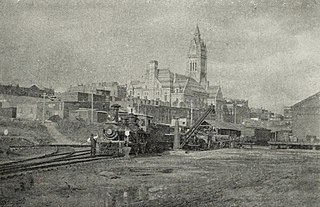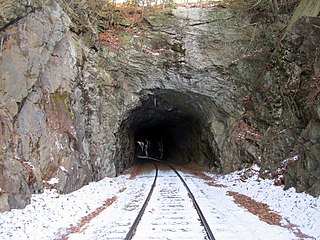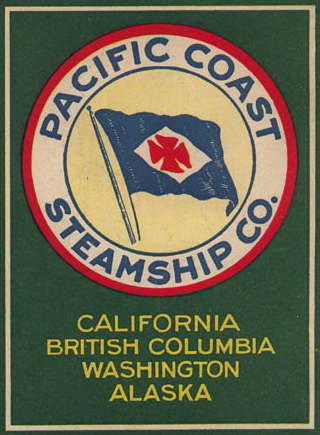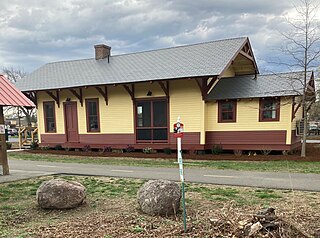Related Research Articles

The New York, New Haven and Hartford Railroad, commonly known as The Consolidated, or simply as the New Haven, was a railroad that operated principally in the New England region of the United States from 1872 to 1968. Founded by the merger of the New York and New Haven and Hartford and New Haven railroads, the company had near-total dominance of railroad traffic in Southern New England for the first half of the 20th century.
The Lehigh Valley Railroad was a railroad in the Northeastern United States built predominantly to haul anthracite coal from the Coal Region in Northeastern Pennsylvania to major consumer markets in Philadelphia, New York City, and elsewhere.

Henry Bradley Plant, was a businessman, entrepreneur, and investor involved with many transportation interests and projects, mostly railroads, in the southeastern United States. He was founder of the Plant System of railroads and steamboats.

The Providence and Worcester Railroad is a Class II railroad operating 612 miles (985 km) of tracks in Rhode Island, Massachusetts, and Connecticut, as well as New York via trackage rights. The company was founded in 1844 to build a railroad between Providence, Rhode Island, and Worcester, Massachusetts, and ran its first trains in 1847. A successful railroad, the P&W subsequently expanded with a branch to East Providence, Rhode Island, and for a time leased two small Massachusetts railroads. Originally a single track, its busy mainline was double-tracked after a fatal 1853 collision in Valley Falls, Rhode Island.

The Old Colony Railroad (OC) was a major railroad system, mainly covering southeastern Massachusetts and parts of Rhode Island, which operated from 1845 to 1893. Old Colony trains ran from Boston to points such as Plymouth, Fall River, New Bedford, Newport, Providence, Fitchburg, Lowell and Cape Cod. For many years the Old Colony Railroad Company also operated steamboat and ferry lines, including those of the Fall River Line with express train service from Boston to its wharf in Fall River where passengers boarded luxury liners to New York City. The company also briefly operated a railroad line on Martha's Vineyard, as well as the freight-only Union Freight Railroad in Boston. The OC was named after the "Old Colony", the nickname for the Plymouth Colony.

The Newburgh, Dutchess and Connecticut Railroad was a railroad in Dutchess County, New York, United States. Its line ran 58.9 miles (94.8 km) northeast from the Hudson River in Fishkill to the Connecticut state line near Millerton. The Dutchess and Columbia Railroad (D&C), was chartered in 1866 to link rural villages with the Hudson River Railroad and New York and Harlem Railroad. The under-construction line was leased by the Boston, Hartford and Erie Railroad (BH&E) in 1868. The first segment opened in July 1869, and it reached Pine Plains the following February.

The Pacific Mail Steamship Company was founded April 18, 1848, as a joint stock company under the laws of the State of New York by a group of New York City merchants. Incorporators included William H. Aspinwall, Edwin Bartlett, Henry Chauncey, Mr. Alsop, G.G. Howland and S.S. Howland.

The New York, Providence and Boston Railroad, normally called the Stonington Line, was a major part of the New York, New Haven and Hartford Railroad between New London, Connecticut and Providence, Rhode Island. It is now part of Amtrak's high-speed Northeast Corridor.

Hoboken Shore Railroad, initials HSRR, was a New Jersey railroad which was created around 1954. It took over the activities of the Hoboken Manufacturers Railroad, initials HMRR. This railroad owned only 0.221 miles (0.356 km) of mainline but around 1906 leased the longer route of the Hoboken Shore Road which had been operated since 1897 by the Hoboken Railroad Warehouse and Steamship Connecting Company, initials HRRWH&SSConCo or HRRW&SSCCO.

The Connecticut Company was the primary electric street railway company in the U.S. state of Connecticut, operating both city and rural trolleys and freight service. It was controlled by the New York, New Haven and Hartford Railroad, which also controlled most steam railroads in the state. After 1936, when one of its major leases was dissolved, it continued operating streetcars and, increasingly, buses in certain Connecticut cities until 1976, when its assets were purchased by the state government.

The New Haven and Northampton Railroad was a railroad originally built alongside a canal between 1847 and 1850 in Connecticut. Leased by the New York and New Haven Railroad from 1849 to 1869, the railroad expanded northwards to Massachusetts and its second namesake city in 1859. Upon the end of the lease in 1869, the company expanded further into Massachusetts, reaching as far north as Shelburne and Turners Falls.

The history of commercial passenger shipping on the Great Lakes is long but uneven. It reached its zenith between the mid-19th century and the 1950s. As early as 1844, palace steamers carried passengers and cargo around the Great Lakes. By 1900, fleets of relatively luxurious passenger steamers plied the waters of the lower lakes, especially the major industrial centres of Chicago, Milwaukee, Detroit, Cleveland, Buffalo, and Toronto.

The Tuckerton Railroad was a railroad that operated in New Jersey from 1871 to 1936. The Southern New Jersey Railroad operated part of the line from 1937 to 1940.

Asbury Park was a high-speed coastal steamer built in Philadelphia, and intended to transport well-to-do persons from New York to summer homes on the New Jersey shore. This vessel was sold to West Coast interests in 1918, and later converted to an automobile ferry, serving on various routes San Francisco Bay, Puget Sound and British Columbia. This vessel was known by a number of other names, including City of Sacramento, Kahloke, Langdale Queen, and Lady Grace.

The Norwich and Worcester Railroad (N&W) was a railroad in the U.S. states of Connecticut and Massachusetts. Its north-south mainline ran between its namesake cities of Worcester, Massachusetts, and Norwich, Connecticut,. The Providence and Worcester Railroad (P&W) owns the ex-N&W line and operates freight service.
The Metropolitan Steamship Company was for 75 years one of the chief transportation links between New York City and Boston, Massachusetts. It was closely associated with the Whitney family until its acquisition by Charles W. Morse in 1906. Even after being merged into Eastern Steamship Lines, it was maintained as a distinct service, the Metropolitan Line, until 1941.

The Pacific Coast Steamship Company was an important early shipping company that operated steamships on the west coast of North America. It was first organized in 1867 under the name Goodall, Nelson and Perkins. The Goodall, Nelson & Perkins Steamship Company was formed in 1875, but a year later was reorganized as the Pacific Coast Steamship Company. In 1916 the Admiral Line bought the shipping interests of the company.

The Connecticut Valley Railroad was a railroad in the state of Connecticut founded in 1868. The company built a line along the Connecticut River between Hartford and Old Saybrook, which opened in 1871. It was reorganized as the Hartford and Connecticut Valley Railroad in 1880, and leased by the New York, New Haven and Hartford Railroad in 1887. Following partial abandonments by the New Haven Railroad and successor Penn Central Transportation Company between 1968 and 1972, the line south of Middletown was revived as the Valley Railroad, a heritage railroad, while the portion in Middletown and northward saw operation by several freight railroads. As of 2022, the Providence and Worcester Railroad and Connecticut Southern Railroad both operate portions of the former Connecticut Valley Railroad.
Chartered in 1886, the Canandaigua Street Railroad was a local streetcar line serving the lakeside city of Canandaigua, New York, beginning in 1887. The railroad was sold to the Canandaigua Electric Light and Railroad which rebuilt and electrified the line in 1892. The Ontario Light and Traction Company purchased it in 1900, and leased the line to the Rochester and Eastern Rapid Railway in 1903. In 1905, the line came under the control of the Mohawk Valley Company, and in turn, New York State Railways in 1909. Operation was converted to bus operation some time in the 1920s, but this service ended when the Rochester and Eastern Rapid Railway shut down on July 31, 1930. The lease of the former Canandaiua lines was allowed to lapse.

The Connecticut Central Railroad was a railroad in Connecticut and Massachusetts, which connected East Hartford, Connecticut and Springfield, Massachusetts. Founded in 1871, it was built between 1874 and 1876, and operated independently until being leased by the New York and New England Railroad in 1880. In the 21st century, the line remains in service between East Hartford and Scantic, Connecticut, and out of service to the Massachusetts state line, beyond which it has been abandoned.
References
- The Era of the Joy Line: A Saga of Steamboating on Long Island Sound. Dunbaugh, Edwin. Greenwood Press: 1982.
- ↑ "Joy Line Crushed by New Haven." New York Times. November 5, 1915.
- ↑ "Joy Line Steamer Sunk in Collision." New York Times. May 8, 1905.